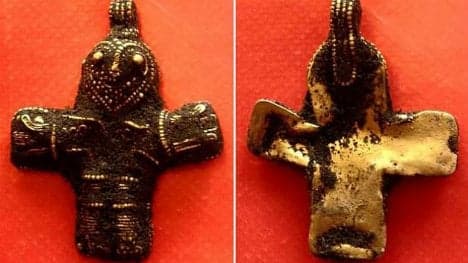1,100 year-old Denmark crucifix ‘may change history’

A cross discovered by an amateur Danish archaeologist may "change history" according to an expert, who believes the cross may date from before Christianity is thought to have reached Denmark.
An amateur archaeologist on the island of Funen made a startling discovery last week – a necklace resembling Jesus on the cross. But after posting a picture of the discovery on Facebook, Dennis Fabricius Holm quickly found that the item may have a lot more significance than he had initially thought.
“I finished work early last Friday, so I decided to spend a couple of hours searching with my metal detector,” Holm told national broadcaster DR.
“Suddenly I hit upon something,” continued Holm. “Ever since I turned over the clump of earth and saw the cross, I’ve been unable to think of anything else.”
Malene Refshauge Beck, archaeologist with East Funen Museums (Østfyns Museer) told DR that she agreed that the necklace is likely to prove a memorable discovery.
“This is a sensational find that dates from the first half of the 10th century CE,” Beck told DR. “There is a near identical figure, found in Sweden, which has been dated to this period.”
The discovery of Christian artefacts from this period in Denmark is particularly remarkable as it predates the Jelling Stone, the giant carved rune stone from the year 965 that is considered to be the earliest Danish representation of Jesus on the cross.
“This figure may therefore result in us reconsidering the date Danes are believed to have become Christian,” said Beck. “The person who wore it would undoubtedly have adhered to the Christian faith.”
While pieces from the period depicting crosses as well as fragments of a piece of jewellery that appeared to depict Jesus have been discovered in the past, the new find is by far the most well-preserved and clear, according to Beck.
The figure will now be further examined at the museum and will go on display at the Ladby Viking Museum this summer.
Editor's note: this article has been edited to correct a previous error regarding the estimated date of origin of the necklace.
Comments
See Also
An amateur archaeologist on the island of Funen made a startling discovery last week – a necklace resembling Jesus on the cross. But after posting a picture of the discovery on Facebook, Dennis Fabricius Holm quickly found that the item may have a lot more significance than he had initially thought.
“I finished work early last Friday, so I decided to spend a couple of hours searching with my metal detector,” Holm told national broadcaster DR.
“Suddenly I hit upon something,” continued Holm. “Ever since I turned over the clump of earth and saw the cross, I’ve been unable to think of anything else.”
Malene Refshauge Beck, archaeologist with East Funen Museums (Østfyns Museer) told DR that she agreed that the necklace is likely to prove a memorable discovery.
“This is a sensational find that dates from the first half of the 10th century CE,” Beck told DR. “There is a near identical figure, found in Sweden, which has been dated to this period.”
The discovery of Christian artefacts from this period in Denmark is particularly remarkable as it predates the Jelling Stone, the giant carved rune stone from the year 965 that is considered to be the earliest Danish representation of Jesus on the cross.
“This figure may therefore result in us reconsidering the date Danes are believed to have become Christian,” said Beck. “The person who wore it would undoubtedly have adhered to the Christian faith.”
While pieces from the period depicting crosses as well as fragments of a piece of jewellery that appeared to depict Jesus have been discovered in the past, the new find is by far the most well-preserved and clear, according to Beck.
The figure will now be further examined at the museum and will go on display at the Ladby Viking Museum this summer.
Editor's note: this article has been edited to correct a previous error regarding the estimated date of origin of the necklace.
Join the conversation in our comments section below. Share your own views and experience and if you have a question or suggestion for our journalists then email us at [email protected].
Please keep comments civil, constructive and on topic – and make sure to read our terms of use before getting involved.
Please log in here to leave a comment.